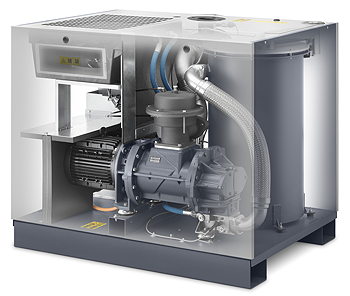- Home » News » Technology News
VSD control halves the energy used by vacuum pumps

Atlas Copco has developed a range of VSD-controlled vacuum pumps that, it claims, will deliver average energy savings of 50% compared to conventional fixed-speed oil-sealed and dry vane vacuum pumps, as well as achieving “best-in-class” noise levels and oil retention. The company says that the development represents “a quantum leap in rough vacuum” which could result in payback periods of a few months in some applications.
Atlas Copco has spent four years developing the GHS 350-900 VSD+ oil-sealed, rotary screw vacuum pumps – including more than 35,000 hours of field trials. The VSD control adapts the vacuum generation to the demands of the process it is supplying. In many applications, it allows the use of a motor one frame size smaller than usual. This, combined with the motors’ IE3 efficiency ratings, contributes to the energy savings.
The vacuum pumps are designed to generate nominal displacements of up to 900m3/h. The initial models are using Yaskawa inverters, but Atlas Copco is planning to use its own drives in larger models that will be launched later. It might also use its own high-efficiency permanent magnet motors in later versions.
Another energy-saving feature is a patented inlet control valve that provides modulating vacuum control in conjunction with the VSD.
At present, many industrial vacuum pumps are controlled simply by switching them on and off. But there are limits on how often their motors can be switched, and the repeated switching can place strains on components such as couplings and vanes, which can delaminate. Users and OEMs therefore often set wide pressure bands for switching their vacuum pumps, thus wasting energy.
The new vacuum pumps share components and technologies with Atlas Copco’s VSD-controlled compressors, including electronic monitoring systems. They are being built in the same factory in Belgium and have been designed to have similar servicing intervals, so can be serviced at the same time. Research shows that about 75% of industrial compressor users also use vacuum pumps – usually, inefficient fixed-speed types – while almost all vacuum pump users also need compressors.
The VSD-controlled vacuum pumps are aimed at the “rough vacuum” applications where, at present, around 75% of users rely on oil-injected technology.
Rough vacuum covers relatively low-vacuum industrial applications such as lifting, handling, forming, shaping, vacuum packing, cooling, freeze drying, conveying and pick-and-place. Atlas Copco also serves the market for higher-vacuum applications using pumps made by its UK subsidiary Edwards, which it bought for $1.6bn in 2013.
The new pumps suck the oil around the circuit rather than pumping it which, Atlas Copco says, makes them more reliable. The company claims that the pumps retain oil more effectively than rival systems, reducing the risk of oil spills and resulting in a cleaner working environment. The air that they discharge is also said to be of a higher quality than usual.

Noise levels down to 51dB(A) are claimed to be about half those of existing oil-sealed and dry-vane vacuum pumps, allowing the new machines to be used on factory floors without disturbing personnel.
In one of the pilot installations, a French baker called Valentin Traiteure has replaced two conventional vacuum pumps, each rated at 5.5kW, by a single VSD-controlled pump with a 7.5kW motor. It is using the pump to package products such as croissants and calculates that it has cut its energy use by around 35%. It has also reduced packaging cycle times by 0.5s – equating to tens of thousands of additional packs over the course of a year.
According to Dirk Villé, general manager of Atlas Copco Compressors in the UK, the new pump will have a similar capital costs to earlier machines. This, combined with the energy savings, will result in payback periods of a few months in many applications, he adds: “It’s almost a no-brainer.”
Initially, Atlas Copco is targeting the end-user market for the new vacuum pumps, but is also talking to potential OEM customers.





